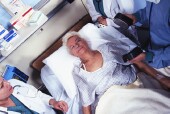
THURSDAY, April 5 (HealthDay News) — Infections, especially among older adults, may increase the risk of developing potentially dangerous blood clots, a new study suggests.
The clots are called venous thromboembolisms, and include the deep vein thromboses (DVTs) that typically begin in the legs. However, DVTs can also travel to the lungs where they form potentially deadly pulmonary embolisms.
DVTs have been linked to prolonged sitting, gaining the nickname “economy-class syndrome” after cases of passengers developing them on long-haul flights.
But, the new study finds that if an older adult suffers an infection (for example, a urinary, skin or respiratory infection) after a stay in a hospital or nursing home, the risk of developing a venous thromboembolism can rise nearly sevenfold. In people who develop infections at home, the researchers found a threefold increased risk of a clot within 90 days.
The report was published in the April 3 online edition of the journal Circulation.
“Preventing infection can have long-term benefits, in ways that one may not expect,” said lead study author Mary Rogers, a research assistant professor in internal medicine at the University of Michigan Medical School.
“This includes fewer problems with blood clots,” she said. “If you do develop an infection — and we all do at times — be more vigilant regarding possible vascular effects. Keep hydrated. Walking helps. See your doctor if problems arise,” said Rogers, who is also research director of the patient safety enhancement program at the University of Michigan Health System and the VA Ann Arbor Healthcare System
For the study, Rogers’ team collected data on more than 16,700 people who took part in the Health and Retirement Study, which is a sample of older Americans.
To find hospitalizations for venous thromboembolism, the researchers linked these data with Medicare records from 1991 to 2007 and found 399 people, averaging 77 years of age, were hospitalized for the condition during the period.
The most common trigger of hospitalization for venous thromboembolism was infection, accounting for 52 percent of the cases, the study authors found.
Besides infection, medications used to treat anemia and blood transfusions were also associated with greater risk of venous thromboembolism. Anemia drugs increased the risk ninefold, according to the report.
Other risk factors included surgery, fractures, being immobile and having had chemotherapy, the researchers pointed out.
Venous thromboembolism is a serious problem, with more than 330,000 Americans hospitalized for it each year, the authors noted.
“Since infection can occur anywhere, it is important that people know that something this common can result in a blood clot,” Rogers said.
Therefore, it is important that preventive measures are a part of daily life, she added. “This includes getting your seasonal flu shot and other recommended vaccinations. This also includes practicing good hygiene and other measures to prevent infection, such as covering your cough,” Rogers advised.
In addition, treatments are available to prevent clotting, including anticoagulants and compression stockings.
“Individuals who are already at higher risk of blood clots, for example, those who are overweight, older, had surgery or a bone fracture, or who have limited mobility, should take precautions,” Rogers said.
Dr. Eric Gandras, associate chief of the division of vascular/interventional radiology at North Shore University Hospital in Manhasset, N.Y., said that “these researchers have identified risk factors for venous thromboembolism that are underappreciated compared to some of the other known risk factors.”
Increased awareness can lead to increased preventive measures and more investigation of how infections result in venous thromboembolism, he said.
Right now it isn’t known whether infection is a cause of venous thromboembolism or is associated with other mechanisms that result in the condition, Gandras said. “We don’t know in terms of direct cause and effect what the exact relationship is,” he said.
More information
To learn more about venous thromboembolism, visit the U.S. National Library of Medicine.

